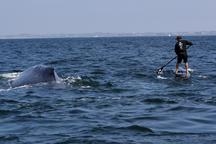
SM BAY — Dozens of giant blue whales are putting on a show along the Southern California coast, and one Santa Monica resident was treated to a front row seat.
While paddle boarding north from Hermosa Beach last week, Mike Vaughan, a third-generation Santa Monican and an avid surfer, nearly collided with a roughly 60-80-foot blue whale as it was feeding on calorie-rich planktonic krill several miles off shore. Vaughan and a buddy, Gene “Tarzan” Smith, captured video footage of the encounter and say they have for the last two weeks seen several small pods, or schools of blue whales, off the coast of the Palos Verdes Peninsula.
“It’s hard to explain how I was feeling,” Vaughan said Thursday of the close encounter (video of the whales can be seen at peprinting.com, the website for Vaughan’s locally-based printing business).
“It’s hard to put into words. Pretty exhilarating. One half of me was like, ‘Wow, this is exciting.’ You get so close to them and they seem like such gentle giants. … Then one came towards me and before we hit, he went right under me, like he could see me. At that point I was super frightened. You kind of wonder if [paddling next to them] is the right thing to do.”
Vaughan said he has not been injured by the whales, who seem preoccupied with feeding.
The whales are appearing in large numbers because of an abundance of krill in the Santa Monica Bay. Some have said they have seen as many as 25 giants at once. This is extraordinary, marine life experts say, considering that there are only 2,000 blue whales documented in the north Pacific Ocean.
Councilman Bob Holbrook called the Daily Press Thursday after he spotted a blue whale in the waters near Casa Del Mar. He said he saw a whale come up for air. When the whale exhaled, Holbrook said mist shot up several feet.
“It looked like a large sail was unfurling,” he said. “It was just like a geyser.”
Smaller gray whales are commonly spotted near these shores in the winter, as they migrate annually from the cold Bering and Chukchi seas to Mexican lagoons to give birth.
But blue whales have only been seen regularly in the past five years. And, before last week, just one or two could be found at a time.
Experts believe a large amount of krill — tiny, shrimp-like creatures and, ironically, some of the smallest animals on the planet — are prospering in the area because of wind-generated upwelling that forces cooler water to the surface. Krill thrive in cool water, and blue whales need to eat about 4,000 pounds of krill a day to sustain their 100-ton girth.
To feed, the whales open their enormous mouths, take a huge gulp, and then sift out the water through broom-like plates hanging from their upper jaw in place of teeth. Then, they swallow the remaining crustaceans. Pleated grooves on their throats allow them to take larger mouthfuls.
Vaughan said he has seen plenty of krill, which look like large, dark patches in the water. He has also seen and smelled the blue whale’s excrement, which he said looks like fluorescent red handle bars from a bicycle.
“It’s all over the place and it reeks,” Vaughan said.
But the smell hasn’t kept Vaughan, who is training for the Battle of the Paddle competition in Dana Point, away from the whales.
“I’ve never seen anything like this,” Vaughan said. “It’s amazing.”
kevinh@www.smdp.com








